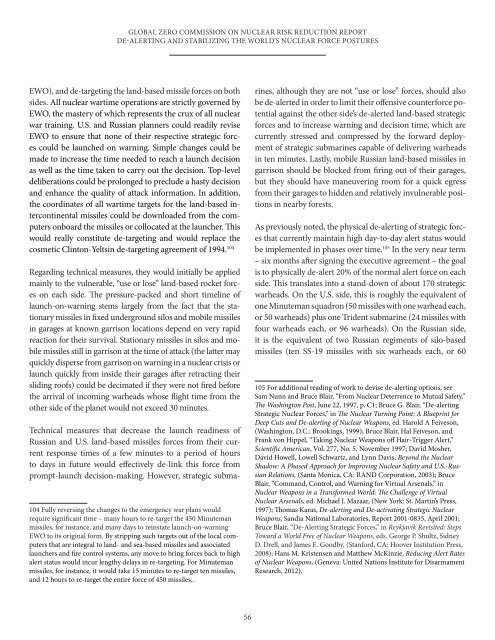global_zero_commission_on_nuclear_risk_reduction_report
global_zero_commission_on_nuclear_risk_reduction_report
global_zero_commission_on_nuclear_risk_reduction_report
Create successful ePaper yourself
Turn your PDF publications into a flip-book with our unique Google optimized e-Paper software.
GLOBAL ZERO COMMISSION ON NUCLEAR RISK REDUCTION REPORTDE-ALERTING AND STABILIZING THE WORLD’S NUCLEAR FORCE POSTURESEWO), and de-targeting the land-based missile forces <strong>on</strong> bothsides. All <strong>nuclear</strong> wartime operati<strong>on</strong>s are strictly governed byEWO, the mastery of which represents the crux of all <strong>nuclear</strong>war training. U.S. and Russian planners could readily reviseEWO to ensure that n<strong>on</strong>e of their respective strategic forcescould be launched <strong>on</strong> warning. Simple changes could bemade to increase the time needed to reach a launch decisi<strong>on</strong>as well as the time taken to carry out the decisi<strong>on</strong>. Top-leveldeliberati<strong>on</strong>s could be prol<strong>on</strong>ged to preclude a hasty decisi<strong>on</strong>and enhance the quality of attack informati<strong>on</strong>. In additi<strong>on</strong>,the coordinates of all wartime targets for the land-based interc<strong>on</strong>tinentalmissiles could be downloaded from the computers<strong>on</strong>board the missiles or collocated at the launcher. Thiswould really c<strong>on</strong>stitute de-targeting and would replace thecosmetic Clint<strong>on</strong>-Yeltsin de-targeting agreement of 1994. 104Regarding technical measures, they would initially be appliedmainly to the vulnerable, “use or lose” land-based rocket forces<strong>on</strong> each side. The pressure-packed and short timeline oflaunch-<strong>on</strong>-warning stems largely from the fact that the stati<strong>on</strong>arymissiles in fixed underground silos and mobile missilesin garages at known garris<strong>on</strong> locati<strong>on</strong>s depend <strong>on</strong> very rapidreacti<strong>on</strong> for their survival. Stati<strong>on</strong>ary missiles in silos and mobilemissiles still in garris<strong>on</strong> at the time of attack (the latter mayquickly disperse from garris<strong>on</strong> <strong>on</strong> warning in a <strong>nuclear</strong> crisis orlaunch quickly from inside their garages after retracting theirsliding roofs) could be decimated if they were not fired beforethe arrival of incoming warheads whose flight time from theother side of the planet would not exceed 30 minutes.Technical measures that decrease the launch readiness ofRussian and U.S. land-based missiles forces from their currentresp<strong>on</strong>se times of a few minutes to a period of hoursto days in future would effectively de-link this force fromprompt-launch decisi<strong>on</strong>-making. However, strategic subma-104 Fully reversing the changes to the emergency war plans wouldrequire significant time – many hours to re-target the 450 Minutemanmissiles, for instance, and many days to reinstate launch-<strong>on</strong>-warningEWO to its original form. By stripping such targets out of the local computersthat are integral to land- and sea-based missiles and associatedlaunchers and fire c<strong>on</strong>trol systems, any move to bring forces back to highalert status would incur lengthy delays in re-targeting. For Minutemanmissiles, for instance, it would take 15 minutes to re-target ten missiles,and 12 hours to re-target the entire force of 450 missiles..rines, although they are not “use or lose” forces, should alsobe de-alerted in order to limit their offensive counterforce potentialagainst the other side’s de-alerted land-based strategicforces and to increase warning and decisi<strong>on</strong> time, which arecurrently stressed and compressed by the forward deploymentof strategic submarines capable of delivering warheadsin ten minutes. Lastly, mobile Russian land-based missiles ingarris<strong>on</strong> should be blocked from firing out of their garages,but they should have maneuvering room for a quick egressfrom their garages to hidden and relatively invulnerable positi<strong>on</strong>sin nearby forests.As previously noted, the physical de-alerting of strategic forcesthat currently maintain high day-to-day alert status wouldbe implemented in phases over time. 105 In the very near term– six m<strong>on</strong>ths after signing the executive agreement – the goalis to physically de-alert 20% of the normal alert force <strong>on</strong> eachside. This translates into a stand-down of about 170 strategicwarheads. On the U.S. side, this is roughly the equivalent of<strong>on</strong>e Minuteman squadr<strong>on</strong> (50 missiles with <strong>on</strong>e warhead each,or 50 warheads) plus <strong>on</strong>e Trident submarine (24 missiles withfour warheads each, or 96 warheads). On the Russian side,it is the equivalent of two Russian regiments of silo-basedmissiles (ten SS-19 missiles with six warheads each, or 60105 For additi<strong>on</strong>al reading of work to devise de-alerting opti<strong>on</strong>s, seeSam Nunn and Bruce Blair, “From Nuclear Deterrence to Mutual Safety,”The Washingt<strong>on</strong> Post, June 22, 1997, p. C1; Bruce G. Blair, “De-alertingStrategic Nuclear Forces,” in The Nuclear Turning Point: A Blueprint forDeep Cuts and De-alerting of Nuclear Weap<strong>on</strong>s, ed. Harold A Feives<strong>on</strong>,(Washingt<strong>on</strong>, D.C.: Brookings, 1999); Bruce Blair, Hal Feives<strong>on</strong>, andFrank v<strong>on</strong> Hippel, “Taking Nuclear Weap<strong>on</strong>s off Hair-Trigger Alert,”Scientific American, Vol. 277, No. 5, November 1997; David Mosher,David Howell, Lowell Schwartz, and Lynn Davis, Bey<strong>on</strong>d the NuclearShadow: A Phased Approach for Improving Nuclear Safety and U.S.-RussianRelati<strong>on</strong>s, (Santa M<strong>on</strong>ica, CA: RAND Corporati<strong>on</strong>, 2003); BruceBlair, “Command, C<strong>on</strong>trol, and Warning for Virtual Arsenals,” inNuclear Weap<strong>on</strong>s in a Transformed World: The Challenge of VirtualNuclear Arsenals, ed. Michael J. Mazaar, (New York: St. Martin’s Press,1997); Thomas Karas, De-alerting and De-activating Strategic NuclearWeap<strong>on</strong>s, Sandia Nati<strong>on</strong>al Laboratories, Report 2001-0835, April 2001;Bruce Blair, “De-Alerting Strategic Forces,” in Reykjavik Revisited: StepsToward a World Free of Nuclear Weap<strong>on</strong>s, eds. George P. Shultz, SidneyD. Drell, and James E. Goodby, (Stanford, CA: Hoover Instituti<strong>on</strong> Press,2008); Hans M. Kristensen and Matthew McKinzie, Reducing Alert Ratesof Nuclear Weap<strong>on</strong>s, (Geneva: United Nati<strong>on</strong>s Institute for DisarmamentResearch, 2012).56


